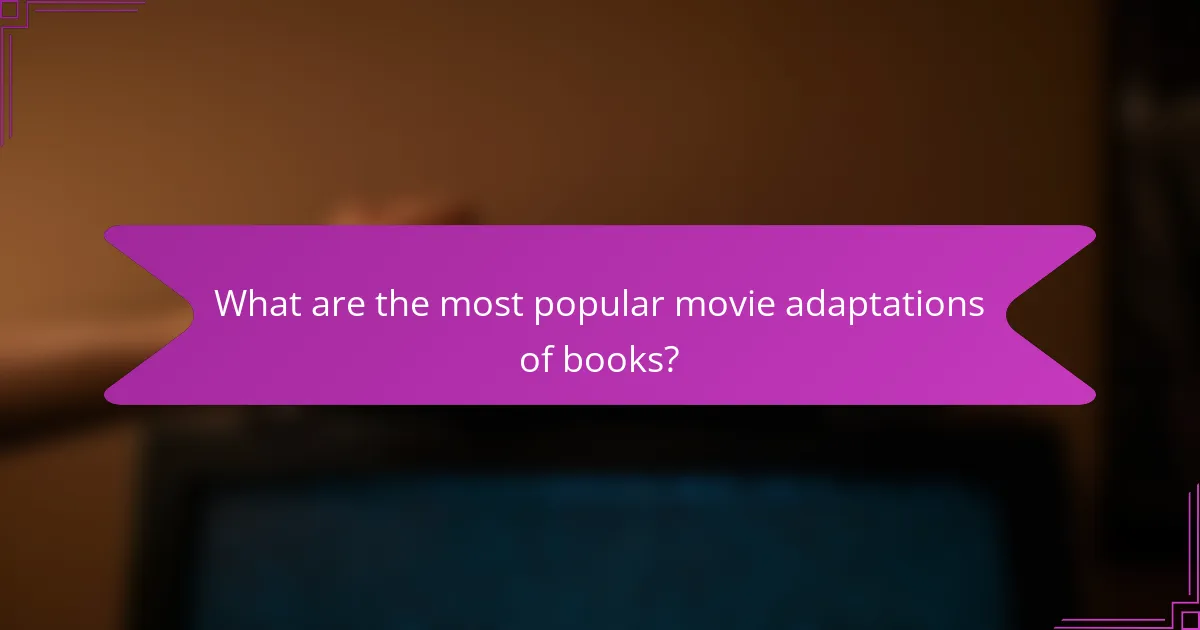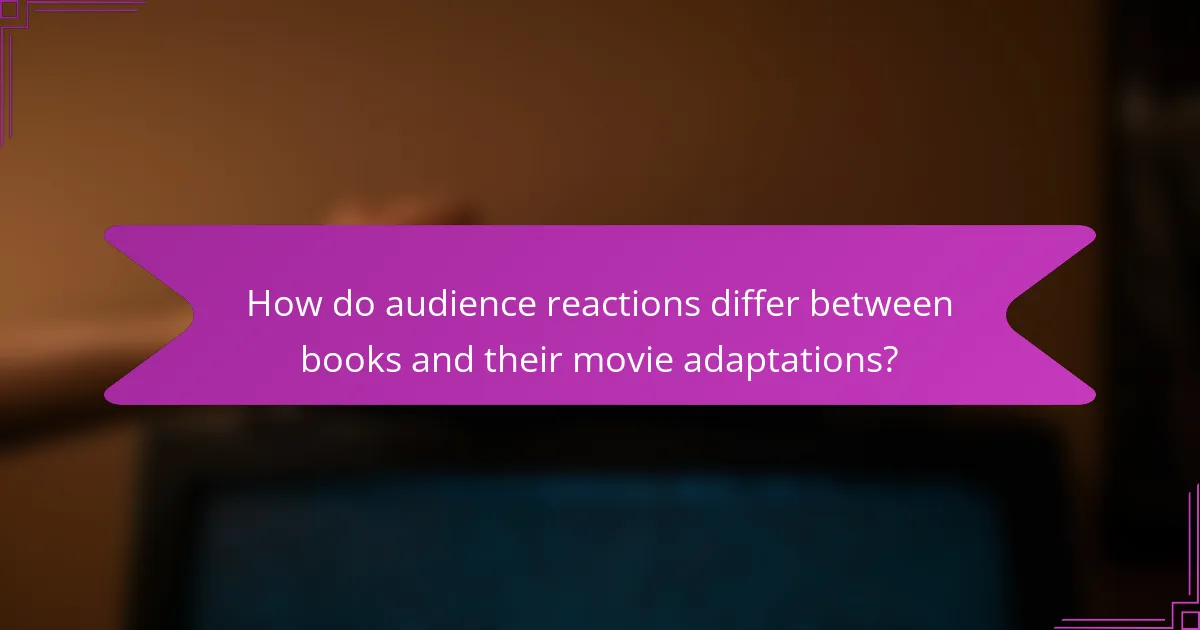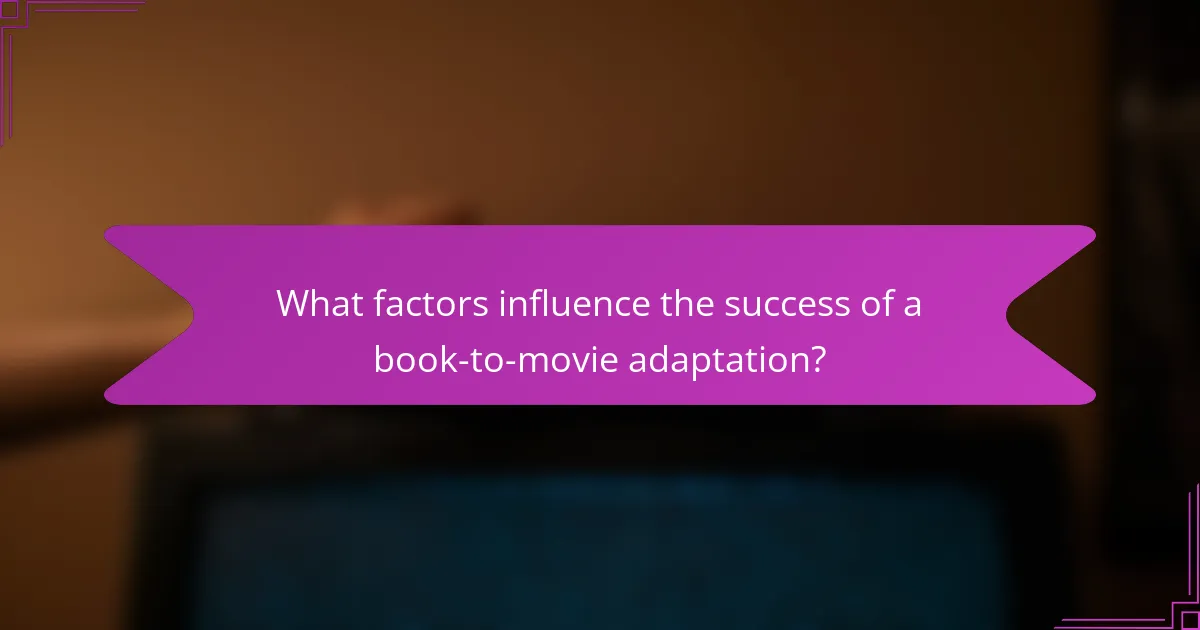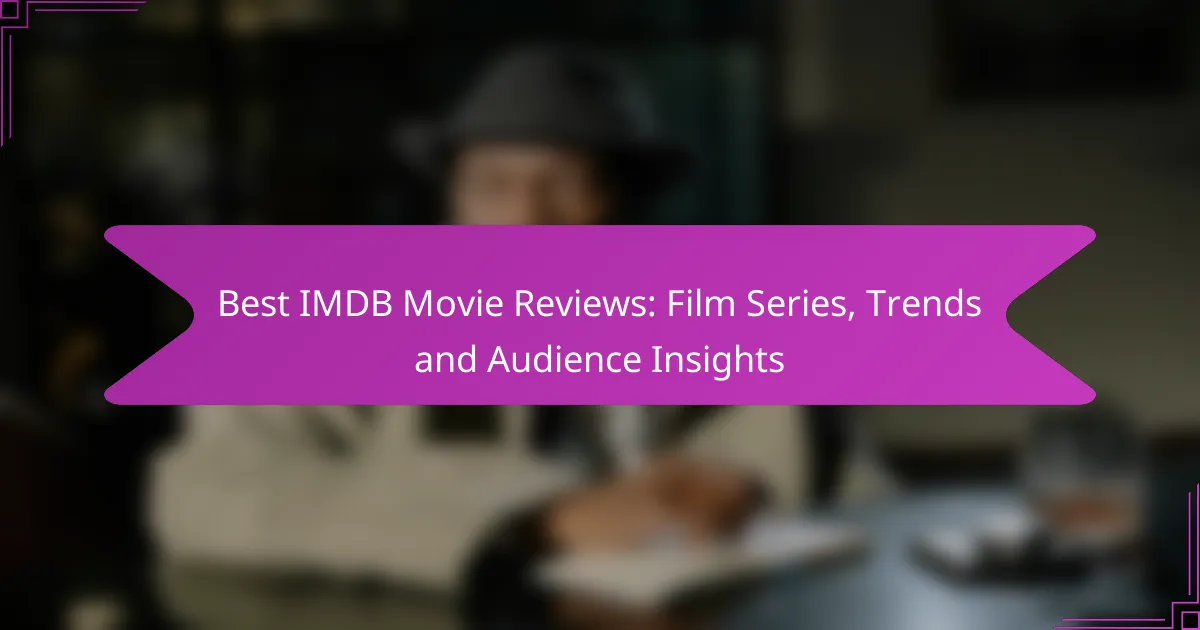Movie adaptations of books have become a significant part of the film industry, often captivating audiences by translating beloved stories into visual narratives. While these adaptations can achieve commercial success and critical acclaim, audience reactions frequently differ due to varying expectations and the inherent differences between written and cinematic storytelling. Factors such as fidelity to the source material, cast appeal, and the director’s vision play crucial roles in shaping how these adaptations are received by viewers.

What are the most popular movie adaptations of books?
Some of the most popular movie adaptations of books have captivated audiences by bringing beloved stories to life on screen. These adaptations often vary in fidelity to the source material, yet they frequently achieve significant box office success and critical acclaim.
The Lord of the Rings series
The Lord of the Rings series, directed by Peter Jackson, is based on J.R.R. Tolkien’s epic fantasy novels. Released in the early 2000s, the trilogy received multiple Academy Awards and is praised for its stunning visuals and faithful representation of Middle-earth.
Key elements to consider include the intricate world-building and character development that Tolkien established, which Jackson effectively translated into cinematic form. Fans appreciate the depth of the story, though some argue that certain subplots were condensed or omitted.
Harry Potter series
The Harry Potter series, adapted from J.K. Rowling’s novels, consists of eight films released between 2001 and 2011. This franchise became a cultural phenomenon, appealing to both children and adults, and grossing billions worldwide.
While the films capture the essence of the books, they also face criticism for leaving out significant details and character arcs. The adaptations are generally well-received, but fans often debate which elements were best represented or altered.
The Great Gatsby
F. Scott Fitzgerald’s The Great Gatsby has been adapted into film several times, with the most notable version released in 2013, directed by Baz Luhrmann. This adaptation is known for its vibrant visuals and modern soundtrack, which contrasts with the 1920s setting of the novel.
While the film captures the novel’s themes of wealth and disillusionment, some critics argue that the stylistic choices overshadow the deeper narrative. Readers should consider how adaptations can reinterpret classic literature while maintaining core messages.
To Kill a Mockingbird
To Kill a Mockingbird, based on Harper Lee’s Pulitzer Prize-winning novel, was adapted into a film in 1962. The movie is celebrated for its powerful performances, particularly Gregory Peck’s portrayal of Atticus Finch, and its poignant exploration of racial injustice in the American South.
This adaptation is often praised for its faithfulness to the source material, effectively conveying the novel’s themes. However, some nuances of the book are inevitably lost in translation, which can lead to different interpretations of the story.
Pride and Prejudice
Pride and Prejudice, originally written by Jane Austen, has seen numerous adaptations, with the 2005 film starring Keira Knightley being particularly popular. This version is known for its romantic portrayal of Elizabeth Bennet and Mr. Darcy, appealing to both Austen fans and new audiences.
While the film captures the essence of the novel’s social commentary and character dynamics, it also takes creative liberties that may not resonate with purists. Viewers should be aware that adaptations can vary significantly in tone and focus, impacting their overall reception.

How do audience reactions differ between books and their movie adaptations?
Audience reactions often vary significantly between books and their film adaptations due to differing expectations, narrative depth, and character development. While some viewers appreciate the visual storytelling of movies, many readers feel that adaptations can overlook crucial elements of the original material.
Critical acclaim for adaptations
Critical acclaim for movie adaptations can vary widely, with some films receiving praise for their fidelity to the source material while others are criticized for diverging too much. For instance, adaptations like “The Shawshank Redemption” and “The Godfather” are often lauded for capturing the essence of their respective novels. However, adaptations such as “Percy Jackson & The Olympians” have faced backlash for not meeting fan expectations.
Critics often assess adaptations based on factors like screenplay quality, acting, and direction, which can lead to polarized opinions. A well-received adaptation can enhance the book’s popularity, while a poorly executed film might detract from the original work’s reputation.
Viewer expectations vs. reality
Viewer expectations can significantly influence reactions to adaptations. Many fans approach a film with a strong attachment to the book, anticipating a faithful representation of characters and plot. When movies take creative liberties, such as altering key storylines or character arcs, it can lead to disappointment.
To manage expectations, readers should consider that films often condense complex narratives into shorter runtimes, which can result in omitted details. Understanding that adaptations may prioritize visual storytelling over narrative depth can help viewers appreciate the film on its own terms.
Fan reactions on social media
Social media platforms are a hotbed for fan reactions to movie adaptations, where audiences share their thoughts and critiques almost instantly. Hashtags related to adaptations often trend, showcasing a mix of excitement and disappointment. Fans frequently express their opinions through memes, reviews, and discussions, creating a vibrant dialogue around the adaptation.
Engagement on platforms like Twitter and Instagram can amplify both positive and negative reactions, influencing public perception. Fans may rally around or against adaptations, leading to movements that can affect a film’s box office performance and critical reception. Understanding this dynamic can help creators gauge audience sentiment and improve future adaptations.

What factors influence the success of a book-to-movie adaptation?
The success of a book-to-movie adaptation is influenced by several key factors, including how faithfully the film represents the source material, the star power of the cast, and the director’s unique vision and style. Each of these elements can significantly impact audience reception and box office performance.
Faithfulness to source material
Faithfulness to the source material is crucial for satisfying fans of the original book. While some adaptations take creative liberties, staying true to the plot, characters, and themes often resonates better with audiences. A balance must be struck between artistic interpretation and maintaining the essence of the story.
For instance, adaptations like “The Lord of the Rings” have been praised for their fidelity to J.R.R. Tolkien’s work, while others, such as “The Golden Compass,” faced criticism for diverging too much from the original narrative. Filmmakers should consider which elements are essential to the story and which can be modified without losing impact.
Star power and casting choices
Star power and casting choices play a significant role in attracting audiences to a film adaptation. Well-known actors can draw in viewers and lend credibility to the project. The right casting can also enhance character portrayal, making them more relatable and engaging.
For example, the casting of Daniel Radcliffe as Harry Potter helped bring J.K. Rowling’s beloved character to life, contributing to the franchise’s massive success. Conversely, miscasting can lead to audience disappointment and negatively affect box office performance. Filmmakers should carefully consider how actors embody their roles and their ability to connect with the audience.
Director’s vision and style
The director’s vision and style are pivotal in shaping the overall tone and aesthetic of a movie adaptation. A director with a clear understanding of the source material can create a film that resonates with both fans and newcomers. Their unique approach can elevate the narrative and provide a fresh perspective on familiar stories.
For instance, Guillermo del Toro’s adaptation of “Pan’s Labyrinth” showcased his distinctive style, blending fantasy with dark themes, which appealed to both critics and audiences. Filmmakers should ensure that the director’s vision aligns with the story’s core elements to create a cohesive and compelling adaptation.

What are common criticisms of movie adaptations?
Common criticisms of movie adaptations often revolve around how they fail to capture the essence of the source material. Viewers frequently express dissatisfaction with omissions, character portrayals, and shifts in tone or theme that can alter the original narrative’s impact.
Omission of key plot points
Many movie adaptations leave out significant plot points from the original books, which can frustrate fans. These omissions may occur due to time constraints, with films typically running for around 90 to 180 minutes, limiting the amount of content that can be included.
For example, adaptations of lengthy novels often condense complex storylines, resulting in a loss of depth. This can lead to confusion for viewers unfamiliar with the source material, as essential context may be missing.
Character development issues
Character development is another area where movie adaptations frequently fall short. In books, characters often undergo extensive growth and exploration, while films may simplify these arcs for brevity, leaving characters feeling one-dimensional.
For instance, a character’s internal struggles and motivations might be glossed over in favor of action or visual storytelling. This can diminish the emotional resonance of the story, making it harder for audiences to connect with the characters.
Changes in tone or theme
Changes in tone or theme can significantly alter the viewer’s experience of a story. Adaptations may shift from a serious, contemplative narrative to a more lighthearted or action-oriented approach, which can alienate fans of the original work.
For example, a dark fantasy novel might be transformed into a family-friendly film, losing its original message and emotional weight. Such changes can lead to mixed reactions from audiences, as they may feel the adaptation does not honor the spirit of the source material.

How do adaptations impact book sales?
Adaptations can significantly boost book sales by generating renewed interest in the original material. When a movie or series is released, it often leads to increased visibility and demand for the corresponding books, benefiting both authors and publishers.
Increased interest in original books
When a film adaptation is announced, it often sparks curiosity about the source material. This heightened interest can lead to a surge in online searches and discussions, prompting readers to explore the original books. Social media platforms and book review sites frequently see a spike in activity related to these titles.
For instance, popular adaptations like “Harry Potter” or “The Hunger Games” have not only maintained their readership but also attracted new fans who wish to delve deeper into the stories. This trend highlights the symbiotic relationship between films and their literary counterparts.
Sales spikes post-release
Book sales typically experience noticeable spikes following the release of a film adaptation. These spikes can vary widely, often ranging from 20% to over 100% depending on the film’s popularity and marketing efforts. Publishers usually prepare for these surges by increasing stock and promoting the books through various channels.
For example, when “The Great Gatsby” was adapted into a film, sales of the book soared, reflecting the film’s box office success and cultural impact. This pattern is common across many adaptations, showcasing the potential for significant financial gains for authors and publishers alike.
Merchandising opportunities
Adaptations open up various merchandising opportunities that can further enhance book sales. Merchandise related to a film, such as collectibles, apparel, and themed products, often includes references to the original books, driving additional interest and sales. This cross-promotion can create a broader market for both the film and the book.
For instance, merchandise from adaptations like “Game of Thrones” not only sells well on its own but also encourages fans to read the original “A Song of Ice and Fire” series. Publishers can collaborate with film studios to create bundled offers or special editions that capitalize on this synergy.

What are the trends in recent adaptations?
Recent adaptations of books into movies are increasingly influenced by audience preferences and the rise of streaming platforms. These adaptations often prioritize character depth and narrative complexity to engage viewers more effectively.
Rise of streaming service adaptations
Streaming services have become major players in the adaptation landscape, producing a wide array of content based on popular literature. Platforms like Netflix, Amazon Prime, and Hulu invest heavily in adapting novels and series, often resulting in higher production values and more nuanced storytelling.
These adaptations typically feature serialized formats, allowing for deeper character development and plot exploration compared to traditional films. For example, series like “The Witcher” and “The Handmaid’s Tale” have successfully translated complex narratives from page to screen, attracting large audiences and critical acclaim.
When considering adaptations for streaming, it’s essential to evaluate the source material’s potential for episodic storytelling. Not all books translate well into a multi-episode format, so selecting works with rich narratives and character arcs can enhance viewer engagement.



